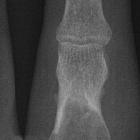Maffucci syndrome






Maffucci syndrome is a congenital nonhereditary mesodermal dysplasia characterized by multiple enchondromas with soft-tissue venous malformations (hemangiomas).
On imaging, it is usually portrayed by a short limb with metaphyseal distortions due to multiple enchondromas, which may appear grotesque, and soft tissue masses with phleboliths depicting hemangiomas.
Epidemiology
There is a recognized male predilection.
Clinical presentation
The clinical symptoms of Maffucci syndrome are present at birth or manifest in the 1st year of life in approximately a quarter of cases. In just under half of cases, the onset of symptoms is before the age of 6 years, and in three-quarters of cases, symptoms start before puberty. The hemangiomas appear as blue subcutaneous nodules that can be emptied by manual compression.
Distribution
The distribution of enchondromas is similar to Ollier disease with the hands and feet most often being affected. The skeletal and vascular lesions in the extremities are usually asymmetrically distributed, with unilateral changes seen in about 50% of patients.
The hemangiomas are mostly located in the subcutaneous soft tissues.
Associations
Radiographic features
Plain radiograph
Radiographic appearances are nearly pathognomonic, with multiple enchondromas seen associated with soft tissue swelling and phleboliths.
Treatment and prognosis
When there is a shortening of the involved limb, orthopaedical surgery for limb lengthening is usually performed during childhood.
Complications
Enchondromas degenerate into chondrosarcomas in 15-51% of cases and soft-tissue hemangiomas to vascular sarcomas in 3-5%. Additionally, there is also an increase in other malignancies (pancreatic carcinoma and gliomas).
History and etymology
First described in 1881 (prior to Ollier syndrome) by Angelo Maffucci, an Italian pathologist (1847-1903).
Siehe auch:
und weiter:
- Café-au-lait-Fleck
- Chondrom
- macrodystrophia lipomatosa
- Proteus-Syndrom
- Knochentumoren
- kongenitale vaskuläre Malformationen
- conditions involving skin and bone
- Gefäßverkalkungen
- premature closure of a growth plate
- Chondromatose
- Blue-rubber-bleb-naevus-Syndrom
- Granulosazelltumor des Ovars
- syndromes with a vascular component
- Dyschondroplasia
- juveniler Granulosazelltumor des Ovars
- pseudo madelung deformity maffucci
- vaskuläre Syndrome

 Assoziationen und Differentialdiagnosen zu Maffucci-Syndrom:
Assoziationen und Differentialdiagnosen zu Maffucci-Syndrom:




